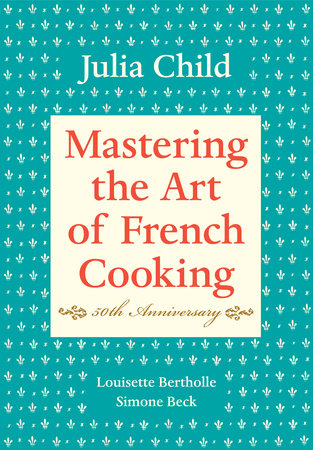- Home •
- Books by Category •
- Imprints •
- News •
- Videos •
- Media Center •
- Reading Group Center
Julia Child's Reine de Saba Recipe, for Mastering's 50th Birthday
Some things just get better with age. Cooking with a Julia Child recipe means you’re in for a master class, and Julia’s passion, her humor, and her joy for cooking have made her an icon in the literary and culinary worlds. And now we can celebrate the 50th birthday of her groundbreaking cookbook, Mastering the Art of French Cooking—newly available in e-book form, and just as delicious as it has always been. As a celebration of Julia’s legacy, and this new stage of her famous cookbook’s life, I decided to bake a cake in her honor—the exquisite Reine de Saba (Chocolate Almond Cake), named for the Queen of Sheba and enjoyed in kitchens all over the world.
When we were looking through the submissions for our “Be Like Julie, Cook from Julia” contest two years ago, this cake appeared more than any other dessert…but we were never surprised at its popularity. It’s a classically rich and decadent chocolate cake, but the beauty of the finished product, garnished with slivered almonds, makes it a real stunner. Julia notes that this cake’s center should remain “slightly underdone,” so it has a ganache-like consistency, a result of gently folding frothy egg whites and pulverized almonds into the melted chocolate and creamed butter.
Click the thumbnail below to download a PDF of this recipe:
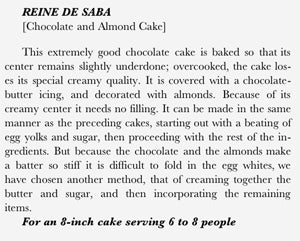

A few things are worth noting about this recipe while you gather your ingredients:
1) Julia asks for a few ounces of semisweet chocolate with a few tablespoons of either rum or coffee. I had on hand a very high-quality bar of Scharffen Berger bittersweet chocolate, which though excellent for baking (with 70% cocoa content) produces a far less sweet cake than using semisweet chocolate (most often used in chocolate-chip cookies). However, I thought about the different kinds of chocolate available when Julia was writing her recipes. In 1961, you’d be lucky to find something other than Tollhouse chips at the grocery store. And with so many chocolate options available today, I try to use dark chocolates whenever possible, because then I can adjust it to make as sweet as I want it. So I ended up melting the bittersweet chocolate with the rum (chocolate takes alcohol very well, and using a spiced rum deepened the flavor beautifully) and adding sugar to taste until it was sweet but not cloying.
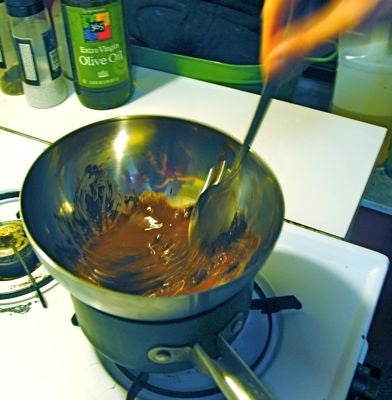
2) Julia also asks that you use cake flour to ensure a fluffy (not floury) batter. I hate keeping specialty flours in my already crowded pantry, so I made my own cake flour instead. To make 1 cup cake flour, measure out 1 cup flour into a flour sifter or fine mesh sieve, then remove 2 tablespoons. Replace the removed flour with two tablespoons of cornstarch—this will lower the protein content of the flour, giving you a silkier, lighter texture. Sift the whole thing a few times, and voila—cake flour!

3) This recipe asks that you provide 3 egg yolks and 3 egg whites. If you feel up to the tricky task of separating your eggs by tossing the egg yolk back and forth between the empty shells, go ahead, but if you’re feeling clutzy like me, just go ahead and crack all three eggs into a single bowl, then use your hands to gently lift the yolks into their own separate bowl. It’s an easy way to make sure you don’t break the yolks and contaminate the whites, which need to be pristine and yolk-free (or they won’t whip up properly.)

OK, enough technique talk, let’s get baking! Butter and flour your cake pan, then get your over preset to 350 degrees. Set a pot of water over medium heat until it comes to a low rolling simmer, then set your chocolate and rum/coffee combo over it in a small metal bowl. Stir the chocolate gently until it completely melts (keep the heat low so the chocolate doesn’t scorch). If you’re using a chocolate with a high cocoa content (as I was), add a tablespoon or two of milk, just to wet the chocolate and give it enough milk solids to melt into a liquid rather than a paste. Meanwhile, use a wooden spoon to stir up softened butter and granulated sugar in a large bowl until they turn creamy and yellow. (It will take a while if you don’t have an electric mixer, but if Julia could do it pre-Cuisinart, so can you.) Plop in the egg yolks and stir to combine until a bright yellow mash forms. (Avoid licking your spoon clean.)
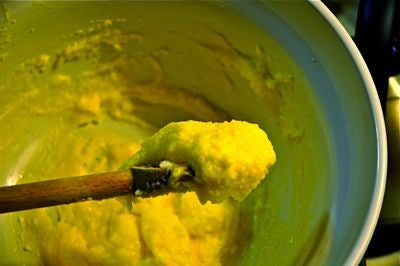
Beat your egg whites with a whisk, along with a pinch of salt, in a separate bowl until it thickens and starts to foam. Add a tablespoon of sugar and whisk the egg whites into submission until you see the stiff peaks of a meringue. This is key to getting that fluffy finished texture, so even if your arm gets tired, don’t give up.
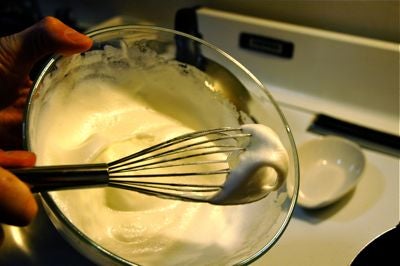
Make sure you do this next part quickly, so you don’t lose the stiffness of your meringues: blend the melted chocolate into your creamed butter-sugar-egg mix, then stir in your pulverized almonds and almond extract (to make pulverized almonds, just throw a bunch into a food processor and pulse until they look like coarse cornmeal). Use a spatula to fold in a quarter of your whipped egg whites scooping the batter up and over them. (Imagine you’re tucking the egg whites under a blanket of batter—this way you won’t break up the structure of the meringue, even as you incorporate it into the batter.)
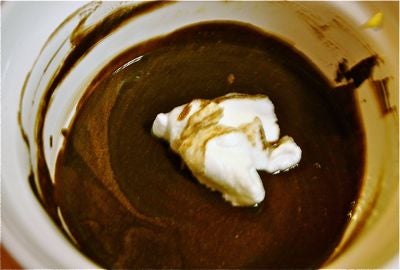
Continue to fold in the egg whites, alternating with folding in your cake flour, until you’ve incorporated it all into the finished batter. Pour the batter into the cake pan and bake for 25 minutes. Use a toothpick to check that it’s puffed and firm around the edges, but slightly wet and oily in the center (again, we want it to be a little underdone). Remove and let the cake cool completely. Meanwhile, you can make the frosting—the Glaçage au Chocolat, some of the densest, creamiest buttercream chocolate frosting you’ll ever have.
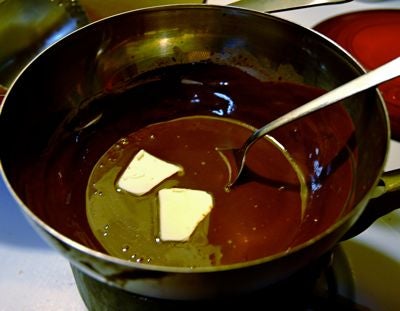
Again set up your double-boiler, of chocolate and rum/coffee in a metal bowl over simmering water, letting it melt until smooth. Once the chocolate has melted, remove from heat and add in 5-6 tablespoons of butter, a little bit at a time, until soft and creamy. Remove your frosting bowl from heat and place it over a bowl of ice water, stirring all the while. The change in temperature will help the frosting thicken and become nice and spreadable.

Before frosting, make absolutely sure that both your cake and your frosting are no longer warm—otherwise it won’t be thick enough to stay on the cak
e, and you’ll be dripping all over the place.
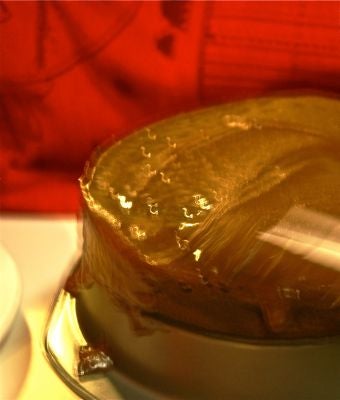
Once the cake and frosting are cool, use a spatula or butter knife to thickly frost the cake on all sides, dipping your utensil into a cup of lukewarm water between coats to keep the frosting smooth. Finally, use your fingers (or a spatula, if you’re feeling very confident) to press a layer of thinly sliced almonds all around the side of the cake in whatever pattern you like.
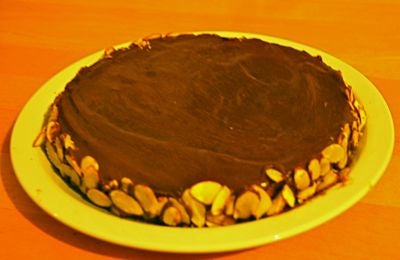
And there you have it—Julia Child’s Reine de Saba. Fit for the queen of Sheba, made for and by us “servantless cooks,” and now available in your e-book edition of Mastering the Art of French Cooking for the first time. Enjoy with a tall glass of milk, a bunch of friends, and your chocolate-splattered e-reader. Bon appétit to you all, and bonne anniversaire to this timeless book!
